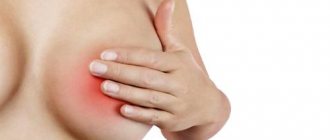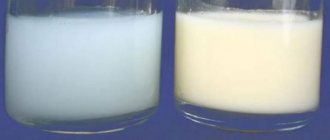Pain and palpable lumps in the chest can be a manifestation of various diseases. In most cases they are benign in nature. Malignant diseases develop much less frequently. In order to determine the exact cause of these symptoms, you need to consult a doctor.
- Why does a lump appear in the breast?
- Lumps and tenderness in the mammary gland during pregnancy and breastfeeding
- Self-examination of the mammary glands
- Diagnostics
- Treatment
- Prevention
Why does a lump appear in the breast?
Lumpiness in the chest along with painful sensations occurs with various diseases. These include:
- Benign breast tumor. Depending on the origin, adenoma, lipoma, fibroma and other neoplasms are distinguished. The tumor is a volumetric compaction. There may be one or more such formations in the breast tissue. The lump may be painful or may be painless. In some cases, breast discomfort occurs before or during menstruation.
- Breast cyst. This is a spherical or oval seal, represented by a cavity filled with liquid contents. This condition is most characterized by pain and discharge from the nipple.
- Nodular or diffuse mastopathy. It is characterized by the appearance of single or multiple compactions in the breast tissue as a result of hormonal imbalance. Symptoms of this condition are areas of palpable lumps and cysts in the tissues, pain and swelling of the mammary gland before menstruation, and discharge from the nipple.
- Malignant breast tumors. They are characterized by the appearance of a lump, a change in the shape of the mammary gland, deformation of the nipple and pathological discharge from it, as well as a change in the skin texture in the projection of the neoplasm. As the disease progresses and metastases appear, the size of nearby lymph nodes increases, their compaction and pain on palpation are noted. In the initial stages, the symptoms of breast cancer may not be pronounced enough.
Types of benign tumors
In most cases, breast lumps are not cancerous. Women may develop one of the following types of tumors.
Fibroadenoma
Fibroadenoma is the most common type of non-cancerous tumor that can develop in the breast in women.
Fibroadenoma is a tumor that is formed by glandular and connective tissues. It is a dense round formation that may have the following characteristics:
- clear boundaries;
- ability to move under the skin;
- no pain;
- hard or elastic structure.
The size of fibroadenoma is usually about 2.5 centimeters. In some cases, these tumors are so small that they can be difficult to feel. However, they are detected using mammography or ultrasound (ultrasound). Sometimes fibroadenomas reach several centimeters in size.
Most often, such tumors develop in women whose age ranges from 20 to 40 years. After menopause, fibroadenomas usually shrink.
Women can develop more than one fibroadenoma. According to the American Cancer Society, the presence of such formations in the breast does not significantly increase the risk of developing breast cancer.
Fibroadenomas do not require treatment in every case. Some of them disappear or decrease on their own. Doctors usually recommend removing such growths if they continue to grow or cause changes in the breast.
Breast cysts
Breast cysts are round, sac-like structures that are filled with fluid. Approximately 25% of the total number of breast formations are cysts. They are not cancerous and do not increase the risk of malignant changes.
Breast cysts usually occur in women in their forties, but they can develop at any age.
Symptoms of breast cysts include the following:
- one or more round, displaced masses under the skin;
- smooth and elastic structure;
- bumps that react with pain to touch.
Doctors use ultrasound to diagnose breast cysts. Cysts that contain only fluid do not require treatment unless they are very large and cause discomfort.
If cysts appear hard or have hard areas when observed during an ultrasound, your doctor may recommend a biopsy to rule out breast cancer.
Fibrocystic breast changes
Increased breast tenderness may be a sign of fibrocystic changes
Fibrocystic breast changes occur due to hormonal fluctuations during menstruation. They cause lumpiness in one or both breasts.
Fibrocystic changes develop over a long period of time and with repeated menstrual cycles. They may cause some discomfort, but do not increase the risk of breast cancer.
Symptoms of fibrocystic changes also include the following:
- increased tenderness or pain in the chest;
- pain in the armpit;
- green or brown discharge from the nipples.
Fibrocystic breast changes do not require treatment, but over-the-counter pain relievers and warm compresses can help relieve discomfort and pain.
Although fibrocystic breast changes are not harmful in most cases, they can make it difficult to self-test for breast cancer. That is why women with this problem should be examined by a doctor more often.
Intraductal papilloma
Intraductal papilloma is a non-cancerous tumor that develops in the milk ducts. This pathology often causes discharge from the nipples.
Women may develop one papilloma near the nipple, but sometimes intraductal papillomas form clusters at some distance from it.
Symptoms of intraductal papilloma include the following:
- swelling of the breast;
- one or more lumps near or under the nipple;
- clear or bloody discharge from the nipples.
Lumps and tenderness in the mammary gland during pregnancy and breastfeeding
During pregnancy and breastfeeding, the ratio of hormone levels in a woman’s body changes. During pregnancy, the corpus luteum and placenta synthesize progesterone, under the influence of which acini and ducts actively develop in the breast tissue - structures necessary for the production and secretion of milk. In the postpartum period, the mammary gland is already capable of lactation. If this process is disrupted, various diseases can develop, including:
- Lactostasis is the stagnation of breast milk in the breast tissue. As a rule, it develops in the early postpartum period. It is characterized by engorgement of the mammary gland, the appearance of compaction in the tissues, a feeling of fullness, and pain on palpation.
- Mastitis. This is an inflammatory disease of the breast of an infectious nature. Most often occurs during lactation. 95% of all cases occur in the postpartum period, 5% develop in pregnant women. Provoking factors are poor breast hygiene, lactostasis, decreased resistance to infection and cracked nipples. The clinical picture of mastitis occurs in stages. At the beginning of the disease, the mammary gland is enlarged in size, swollen, redness and sharp pain on palpation are observed. Additionally, fever and symptoms of intoxication are noted. Further, the inflammation is localized and manifests itself in the form of single or multiple compactions. Without timely treatment, mastitis can result in serious complications - an abscess or phlegmon of the chest.
It is impossible to determine the cause of tightness and pain in the chest area without a visit to a specialist and additional examination. However, certain diagnostics can be carried out independently. If a woman discovers signs of a particular disease, she should consult a doctor as soon as possible.
Possible diseases and their symptoms
In 2/3 of cases, lumps in the breast are associated with certain diseases. They are more common in women aged 30-55 years, when cell growth activity peaks.
Mastitis
This is an inflammatory process that occurs in the breast. It is characterized by fever, malaise, hyperemia of the breast skin, and thickening. Mastitis often results from untreated lactostasis. Stagnant processes in the glands become favorable conditions for infection to penetrate into them and the development of inflammation.
Fibrocystic mastopathy
The most common pathology in which lumps appear in the mammary glands. Seals occur when certain areas of the organ grow excessively. As a result of this process, a woman experiences pain in the affected glands, which, as a rule, changes in character throughout the menstrual cycle. Fibrocystic mastopathy can be diffuse or nodular in nature. With the diffuse type, the bumps spread over all surfaces of the breast. Nodular mastopathy is characterized by single hard lumps that can be easily felt upon palpation.
Benign tumors
Lumps in the mammary glands may indicate the presence of benign neoplasms, which are divided into several types, depending on histological and morphological characteristics:
- Fibroadenomas are growths of fibrous tissue of the mammary gland, as a result of which it appears to predominate over healthy tissue.
- Cysts are tumors limited by a capsule, filled with fluid inside.
- Lipomas are neoplasms formed from adipose tissue of the breast.
- Granulomas are fibrous nodules that arise during prolonged extensive inflammatory processes in the glands.
- Hemangiomas are tumors that affect blood vessels and appear as bloody bumps in the chest area.
READ ALSO: What is mastodynia, how dangerous is chest pain and how to get rid of discomfort with the help of medications and folk remedies
Abscess
Lumps in the mammary glands, which are areas with purulent contents. Most often, an abscess is a complication of an infectious-inflammatory process in tissues (lactostasis, mastitis). If treatment for such diseases is not started in time, pathogenic microorganisms grow and subsequently purulent lesions appear.
An abscess can be suspected based on characteristic signs:
- heat;
- enlargement of regional lymph nodes;
- weakness;
- breast swelling;
- purulent discharge from the nipples is possible.
Mammary cancer
The most dangerous cause of breast lumps. For a long time, the malignant process does not show any symptoms. Cancer cells appear in epithelial and glandular tissues under the influence of various predisposing factors. Breast cancer can be diffuse or nodular, occurring in different parts of the breast. Malignant tumors have a dense structure and are tightly fused with surrounding tissues.
The following symptoms may indicate the progression of breast cancer:
- presence of seals;
- change in breast shape and size;
- hyperemia, swelling of the skin;
- deformation of regional lymph nodes;
- discharge from the nipples, possibly mixed with blood;
- rapid weight loss;
- general weakness.
Self-examination of the mammary glands
The main rule for self-examination and palpation of the breast is regularity. Experts recommend performing a self-examination at least once a month and on the same day of the menstrual cycle. The first step is to examine your breasts. The woman carefully examines the skin for redness, bluish discoloration, rashes, or changes resembling “lemon peel.” You should also check the symmetry of the mammary glands. Slight differences in shape or size are not a symptom of any disease and are considered normal. If the asymmetry appears suddenly, is pronounced or continues to increase, the woman should inform the doctor about it. During further breast examination, the woman stands in front of a mirror and raises her arms up. The presence of retractions may indicate the presence of a malignant tumor.
The next step is to palpate the breast. The hand on the side of the breast being examined is raised behind the head. The fingers are placed flat on the chest. The examination is carried out around the chest - from the nipple to the periphery or vice versa. All areas of the breast should be examined.
You should also pay attention to nipple discharge. They may appear as spots on clothing that touches the breast or appear when pressure is applied to the nipple.
Diagnostics
If a woman has characteristic complaints, a number of diagnostic studies are performed:
- X-ray of the chest. Mammography is a screening diagnostic method that allows you to confirm the presence of a pathological focus in the mammary gland. Ductography is an X-ray contrast study that allows you to visualize the duct system of the breast.
- Ultrasound examination of the mammary glands. Helps determine the location, shape and extent of pathological compaction in the breast tissue. The method is safe and can be performed on pregnant or breastfeeding women.
- Breast biopsy. Histological examination of the breast lump helps to reliably determine the nature of the disease and distinguish a benign tumor from a malignant one.
- Thermography of the chest area - registration of thermal radiation from tissues. The method is based on the fact that actively dividing malignant cells emit more energy and appear redder in the image than surrounding healthy tissue.
To diagnose lumps and pain in the breast, it is mandatory to consult an oncologist-mammologist. An endocrinologist, gynecologist and other specialists may be involved.
General rules and methods of treatment
Treatment tactics are determined by the stage of the pathological process, the nature of the diseases and conditions that caused the appearance of lumps in the breast. In some cases, observational tactics are recommended, in others, drug or surgical treatment.
If the lumps are benign, it is recommended to begin treatment if they grow and significantly increase in size. Some bumps may disappear on their own, for example, if they are associated with physiological processes in the body (appear before menstruation and dissolve after menstruation).
READ ALSO: Enlarged breast size or gynecomastia in men: treatment without surgery, useful recommendations for reducing the risk of relapse
Drug therapy
Since in most cases, lumps in the breast occur due to hormonal imbalance, the basis of treatment in such cases is the use of hormonal drugs. Hyperestrogenism is eliminated with the help of antiestrogens (Tamoxifen, Fareston). To stabilize hormone levels, oral contraceptives can be used, which are selected individually.
Painful sensations are eliminated with the help of NSAIDs and analgesics:
- Paracetamol;
- Indomethacin;
- Nimesulide.
In the case of an inflammatory process in the mammary glands, it is necessary to take antibacterial drugs and antiseptics. If an abscess develops in tissues, surgical intervention, drainage of the affected tissues, and their antiseptic treatment may be required.
Malignant tumors must be removed surgically. Depending on the size of the formation and its location, partial resection of the breast or its complete removal may be performed. Before and after surgery, courses of chemotherapy are required to stop the progression of the malignant process. To prevent relapses, additional hormonal medications, vitamin complexes, and agents to strengthen the immune system are prescribed.
Learn about the causes of pancreatic enlargement and the treatment of the pathological condition.
The rules and features of using the drug Mastopol for the treatment of fibrocystic mastopathy are described on this page.
At https://vse-o-gormonah.com/vnutrennaja-sekretsija/shhitovidnaya/follikulyarnyj-rak.html read about the prognosis of recovery and survival for follicular thyroid cancer.
Traditional medicine recipes
Herbal mixtures, decoctions, infusions and other non-traditional methods can be used as an auxiliary therapy and only with the permission of the attending physician.
For diseases of the mammary glands, you can resort to the following remedies:
- Steamed cabbage leaves help relieve swelling and relieve chest pain. It is applied as a compress.
- Grind dry celandine herb into powder. Mix it with butter (1:2). Heat in a water bath for 10 minutes. Apply as an ointment to problem areas.
- Combine Kalanchoe juice, garlic juice, and honey in equal proportions. Take 1 teaspoon orally in the morning on an empty stomach and before bed.
The video is a fragment from the TV show “Live Healthy!” about the features of treatment of lumps and lumps in the mammary glands:
Treatment
Treatment tactics depend on the cause of the lump and pain in the chest.
With lactostasis, the main task is to empty the mammary gland. To do this, a breast massage is performed; the woman is advised to avoid hypothermia and to put the baby to the breast in a timely manner. Adequate rest and good nutrition will not be superfluous. Night sleep is recommended in the side position. In some cases, oxytocin is prescribed, which stimulates the process of lactation and emptying of the mammary gland.
Antibiotic therapy plays a major role in the treatment of mastitis. The seal usually resolves with rational treatment. The development of purulent mastitis is an indication for surgical intervention.
Multiple or nodular mastopathy is subject to conservative therapy. Drugs are used that normalize hormonal levels. These include combined oral contraceptives, estrogen receptor inhibitors and other drugs.
A benign seal is usually treated surgically, since conservative methods are ineffective. Enucleation or sectoral resection of the mammary gland is used. In the first case, surgeons remove the tumor. There are usually no cosmetic breast defects left with this procedure. Sectoral resection is the excision of a tumor within healthy tissue. After this intervention, a slight deformation of the breast remains, which can be corrected with plastic surgery.
A compaction of a malignant nature is subject to surgical treatment. Mastectomy with removal of regional lymph nodes is recommended. In some cases, excision of the breast tumor within healthy tissue may be performed. The scope of the operation is determined by the oncologist, taking into account the extent of the tumor process. Alternative treatment methods include chemotherapy, radiation therapy, and targeted therapy. They are prescribed in various combinations with each other.
Causes of breast lumps
Formations in the mammary glands can occur under the influence of various circumstances. The key stimulator for the appearance of bumps is hormonal imbalances in the body. They may be associated with changes in the phases of the menstrual cycle, pregnancy, inflammatory processes in the genitals and other conditions. As a rule, changes in the breast occur with hypersecretion of estrogens, prolactin, and progesterone.
The causes of lumps in the mammary glands can be:
- Blockage of the milk ducts during lactation, leading to lactostasis. More often, the condition is caused by improper attachment of the baby to the breast, poor hygiene of the glands, and incomplete emptying.
- Breast injuries in which necrosis of fat cells occurs and compactions appear.
- Infectious lesions of the breast due to the penetration of pathogenic organisms into its tissue. More often this happens due to poor hygiene of the organ.
- Formation of blood clots in the chest.
- Before the onset of menstruation, bumps may appear temporarily, but subsequently they resolve on their own.
- Presence of tumor formations.
- Regular stress.
- Abortion.
- Taking hormonal drugs.
What is the SHBG hormone in men and what is the role of sex hormone binding globulin? We have the answer!
Find out how to lower blood sugar levels with herbs and how to take them from this article.
Prevention
To prevent breast diseases accompanied by thickening and pain, women should adhere to a healthy lifestyle: eat rationally, maintain a work and rest schedule, exercise regularly, avoid stressful situations, stop smoking and abusing alcoholic beverages. If you are overweight, you need to lose weight. You should also choose a comfortable bra that does not squeeze or injure your breasts.
Book a consultation 24 hours a day
+7+7+78









